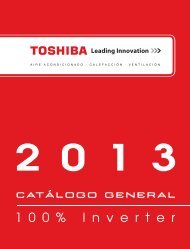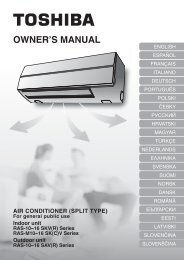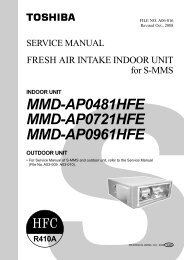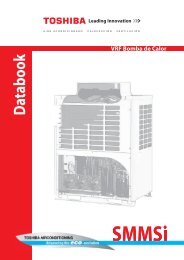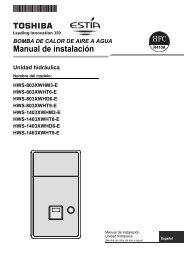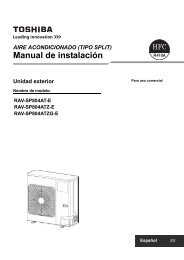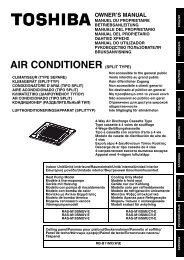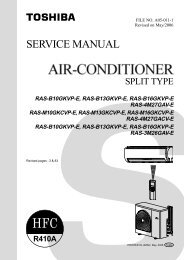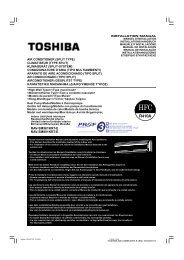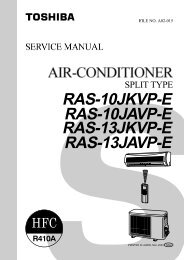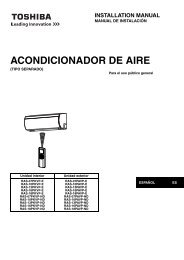MULTI TYPE
MULTI TYPE
MULTI TYPE
You also want an ePaper? Increase the reach of your titles
YUMPU automatically turns print PDFs into web optimized ePapers that Google loves.
8-2. Troubleshooting Method<br />
The remote controllers (main remote controller and central control remote controller) and the interface P.C. board<br />
of an outdoor unit are provided with an LCD display (remote controller) or a 7-segment display (outdoor interface<br />
P.C. board) to display operational status. Using this self-diagnosis feature, the fault site/faulty part may be identified<br />
in the event of a fault by following the method described below.<br />
The list below summarizes check codes detected by various devices. Analyze the check code according to where it is displayed and work out<br />
the nature of the fault in consultation with the list.<br />
• When investigating a fault on the basis of a display provided on the indoor remote controller or TCC-LINK central control remote controller -<br />
See the “TCC-LINK remote control or main remote controller display” section of the list.<br />
• When investigating a fault on the basis of a display provided on an outdoor unit - See the “Outdoor 7-segment display” section of the list.<br />
• When investigating a fault on the basis of a display provided on the AI-NET central control remote controller - See the “AI-NET central control<br />
display” section of the list.<br />
• When investigating a fault on the basis of a wireless remote controller-controlled indoor unit - See the “Light sensor indicator light block”<br />
section of the list.<br />
List of Check Codes (Indoor Unit)<br />
(Error detected by indoor unit)<br />
TCC-LINK<br />
central control<br />
or main remote<br />
controller<br />
display<br />
AI-NET central<br />
control display<br />
(with use of<br />
network<br />
adaptor)<br />
Check code<br />
Outdoor 7-segment display<br />
Sub-code<br />
E03 97 – –<br />
E04 04 – –<br />
Display of receiving unit<br />
Indicator light block<br />
Operation Timer Ready<br />
Flash<br />
Typical fault site<br />
Indoor-remote controller periodic<br />
communication error<br />
Indoor-outdoor periodic<br />
communication error<br />
Description of error<br />
Communication from remote controller or network<br />
adaptor has been lost (so has central control<br />
communication).<br />
Signals are not being received from outdoor unit.<br />
E08 96 E08 Duplicated indoor address Duplicated indoor address Indoor unit detects address identical to its own.<br />
E10 CF – –<br />
E18 97, 99 – –<br />
F01 OF – – ALT<br />
F02 0d – – ALT<br />
F03 93 – – ALT<br />
F10 0C – – ALT<br />
F11 43 – – ALT<br />
Indoor inter-MCU communication<br />
error<br />
Error in periodic communication<br />
between indoor header and<br />
follower unit<br />
Indoor heat exchanger<br />
temperature sensor (TCJ) error<br />
Indoor heat exchanger<br />
temperature sensor (TC2) error<br />
Indoor heat exchanger<br />
temperature sensor (TC1) error<br />
Ambient temperature sensor (TA)<br />
error<br />
Discharge temperature sensor<br />
(TF) error<br />
F29 12 – – SIM P.C. board or other indoor error<br />
L03 96 – – SIM<br />
L07 99 – – SIM<br />
Duplicated indoor group header<br />
unit<br />
Connection of group control cable<br />
to stand-alone indoor unit<br />
L08 99 L08 – SIM Indoor group address not set<br />
L09 46 – – SIM Indoor capacity not set<br />
L20 98 – – SIM Duplicated central control address<br />
L30 b6 L30 Detected indoor unit No. SIM<br />
Indoor external error input<br />
(interlock)<br />
P01 11 – – ALT Indoor AC fan error<br />
MCU communication between main controller and<br />
motor microcontroller is faulty.<br />
Periodic communication between indoor header<br />
and follower units cannot be maintained.<br />
Heat exchanger temperature sensor (TCJ) has<br />
been open/short-circuited.<br />
Heat exchanger temperature sensor (TC2) has<br />
been open/short-circuited.<br />
Heat exchanger temperature sensor (TC1) has<br />
been open/short-circuited.<br />
Ambient temperature sensor (TA) has been open/<br />
short-circuited.<br />
Discharge temperature sensor (TF) has been open/<br />
short-circuited.<br />
Indoor EEPROM is abnormal (some other error may<br />
be detected).<br />
There is more than one header unit in group.<br />
There is at least one stand-alone indoor unit to<br />
which group control cable is connected.<br />
Address setting has not been performed for one or<br />
more indoor units (also detected at outdoor unit<br />
end).<br />
Capacity setting has not been performed for indoor<br />
unit.<br />
There is duplication in central control address<br />
setting.<br />
Unit shutdown has been caused by external error<br />
input (CN80).<br />
Indoor AC fan error is detected (activation of fan<br />
motor thermal relay).<br />
P10 0b P10 Detected indoor unit No. ALT Indoor overflow error Float switch has been activated.<br />
P12 11 – – ALT Indoor DC fan error<br />
P31 47 – – ALT Other indoor unit error<br />
IPDU: Intelligent Power Drive Unit (Inverter P.C. board)<br />
: Lighting, : Flashing, : Goes off<br />
ALT.: Flashing is alternately when there are two flashing LED<br />
SIM: Simultaneous flashing when there are two flashing LED<br />
Indoor DC fan error (e.g. overcurrent or lock-up) is<br />
detected.<br />
Follower unit cannot be operated due to header unit<br />
alarm (E03/L03/L07/L08).<br />
167



